
Typhon and Echidna: Monster Makers of Greek Mythology
Greek mythology is full of terrible monsters. Although it is difficult to choose the worst or most terrible of the Greek monsters, Typhon and Echidna are strong contenders. Both were giant behemoths responsible for birthing a vast number of additional monsters together. As a team, they were so powerful, they even challenged Zeus for supremacy of the cosmos. Their history is long and complicated with multiple versions, so let’s try and straighten it all out.
Typhon and Echidna’s Family Tree
There are multiple origin stories for Typhon, but they are all variations on a theme: women being mad at Zeus. Typhon was usually created as a weapon against Zeus, but who actually birthed him changes from myth to myth.
Typhon is most commonly depicted as the youngest son of Gaia. In Hesiod’s Theogony, it was stated Typhon was the son of Gaia (Earth) and Tartarus (basically Greek hell). Apollodorus, a Greek mythographer from the 1st Century AD, fleshed out the myth. He added that Gaia had Typhon because she was mad at Zeus for destroying the giants, Gaia’s older children. Other versions of this myth had Gaia conceiving Typhon on her own, with no help from Tartarus.
On the other hand, the Homeric Hymn to Apollo from the 6th century BC stated that Hera, Zeus’ wife, was the mother of Typhon. In this version, Hera was mad at Zeus for birthing Athena on his own. Hera prayed to the Titans, Gaia and Uranus, for help and became pregnant with Typhon. She then gave the baby Typhon to the serpent monster Python to raise.
- The Lamia of Ancient Greek Mythology: The Original Bogeyman
- Eight Legendary Creatures from Greek Mythology That You Might Not Know About
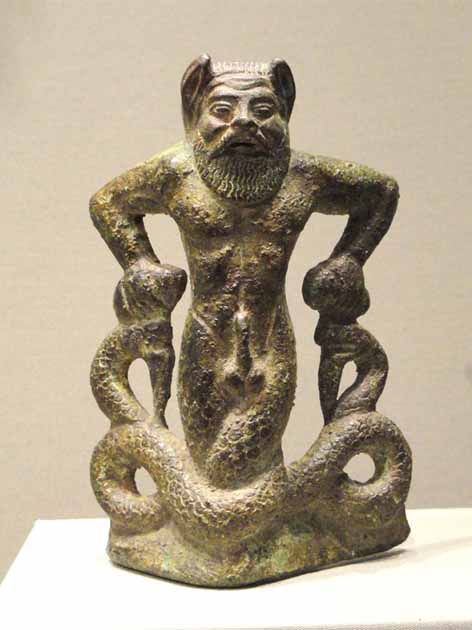
A 5th century BC Etruscan foot element in the form of Typhon (Public Domain)
A later version of the myth seems to combine both versions. It had Cronus (Zeus’ father) as the father of Typhon. Gaia, mad at Zeus for the death of giants, slandered Zeus to Hera. Hera then went to Cronus to ask for help. He gave her two eggs covered in his semen to bury underground, telling her out of one of them would come a being strong enough to defeat Zeus.
Hera did as she was told, and sure enough, Typhon was born. However, by that time Hera had cooled down and forgiven Zeus, so she warned him that a great threat was coming. Whichever version one chooses to look at, the general themes of Typhon’s birth tend to stay the same.
Echidna
Echidna isn’t quite as important as her partner in crime, and so her genealogy wasn’t given quite as much attention. Echidna’s family tree also tended to change from author to author. According to Hesiod, Echidna was born to a “she”, which isn’t particularly helpful. Scholars believe this “she” was the sea goddess Ceto, probably making her father the sea god Phorcys.
Or the “she” could have been an Oceanid called Callirhoe, in which case her father would be Chrysaor, son of Medusa. Conversely, Echidna has been described as the daughter of the Oceanid Styx (goddess of the river Styx). She has also been described as the daughter of Tartarus and Gaia, much like Typhon.
Unlike her partner in crime, no great importance was attributed to Echidna’s parentage. Compared to her more powerful partner, she was just another monster, and so Greek writers would change her genealogy to fit whatever narrative they were telling.
- Fantastic Beasts and Where to Find Them: A History of Monsters, from Werewolves to Hippogriffs
- The Real Story of Medusa: Protective Powers from a Snake-Haired Gorgon
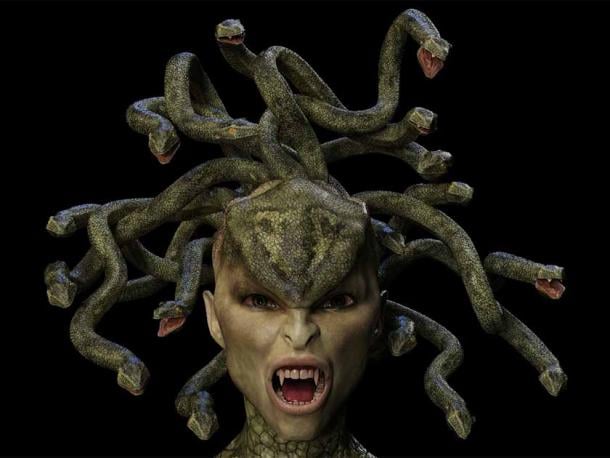
Author descriptions of Echidna differed, but everyone agreed she was hideous to look at (Dina / Adobe Stock)
Monstrous Depictions of Typhon and Echidna
Typhon and Echidna are both described as monsters with a capital M. Almost everything else about them changes from author to author, but tends to follow similar dark themes.
Typhon
Hesiod described Typhon as “terrible, outrageous, and lawless”. According to Hesiod, Typhon was hugely powerful. He had one hundred snake heads, each of which could breathe fire. Pindar and The Homeric Hymn to Apollo both echo Hesiod’s depiction.
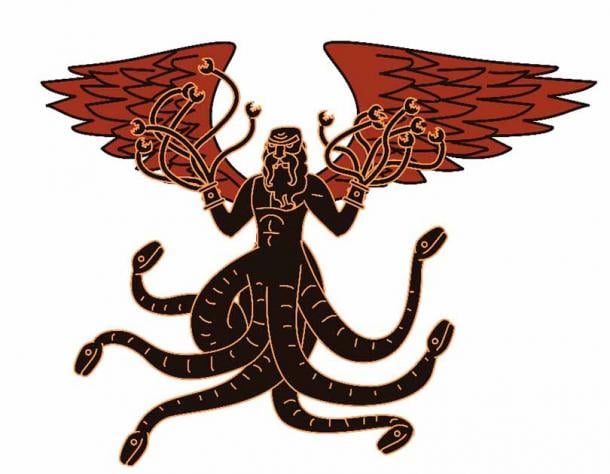
A modern depiction of Typhon, with snakes for legs and arms. With his partner Echidna, fathered a host of monsters (Matiasdelcarmine / Adobe Stock)
A Chalcidian Hydria (540-530 BC) goes into more detail. It has Typhon as a winged humanoid from the waist but with snake tails for legs. The most detailed description however comes from Nonnus’s Dionysiaca. Nonnus doubled down on the serpent imagery for his depiction of Typhon.
According to Nonnus, Typhon had a “tangled army of snakes”. His head, legs, feet, and hair were all made up of snakes. Each of these snakes could belch great clouds of toxins into the air, as well as fire. Along with his snakeheads, Nonnus gave Typhon many other animal heads, ranging from cows and dogs to leopards and lions. Finally, while other authors had given Typhon up to one hundred arms, Nonnus doubled the count to two hundred.
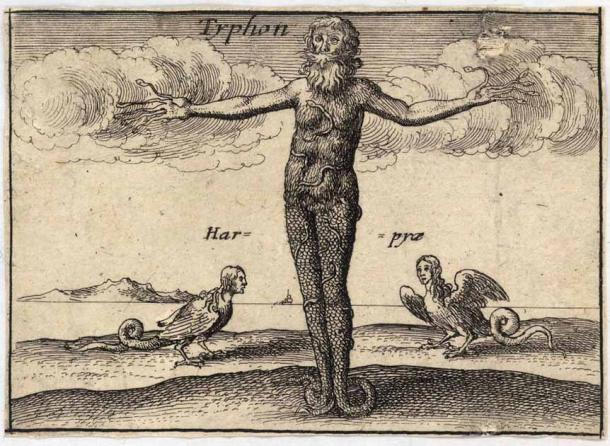
A 15th century drawing of Typhon by Wenceslaus Hollar, with harpies in background (Public Domain)
Echidna is described as monstrous, but not quite as horrifying as her partner. Hesiod described Echidna as being half beautiful woman and half terrible snake. He ascribes her habit of eating raw flesh to her snake half. This has been interpreted as meaning Hesiod’s version of Echidna had a human head on her human half and a snake head on her snake half.
Aristophanes (5th century BC) gave her one hundred snake heads, so that she matched Typhon. Other authors gave her just one head but the body of a snake from the neck down. Finally, Nonnus simply described her as “hideous”.
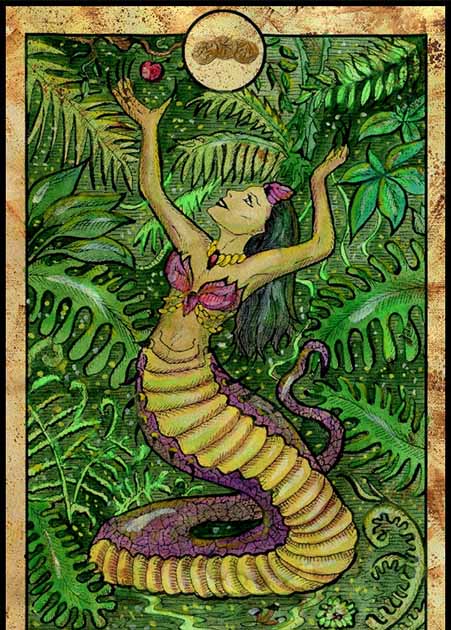
Echidna as depicted on a set of modern tarot cards (samiramay / Adobe Stock)
Typhon and Echidna: Proof That Love is Blind
Apparently, in the case of Echidna and Typhon, beauty is indeed in the eye of the beholder. Hesiod described Typhon as “joined in love” with Echidna, which is surprisingly sweet for two such monsters. We never get much more information than that on how they met; the mythology jumps straight to them making monstrous babies.
Typhon and Echidna’s list of children reads like a ‘who’s who’ of ancient Greek monsters. Their offspring were in the most commonly-known myths, fueling children’s nightmares. As time went on, Greek authors just kept attributing more and more monsters to the coupling of Typhon and Echidna.
Hesiod’s Theogony forms the basis for most Greek writers’ representation of Typhon and Echidna’s children. According to him, their first child was Orthrus, the two-headed dog. He was followed by the infamous Cerberus, the three-headed dog who guarded the entrance to Hades. Third, they had the Lernaean Hydra, the many-headed serpent that grew back two heads for each one it lost. Finally, Hesiod gave them the Chimera, the part-lion, part-goat, part-snake monster that could breathe fire.
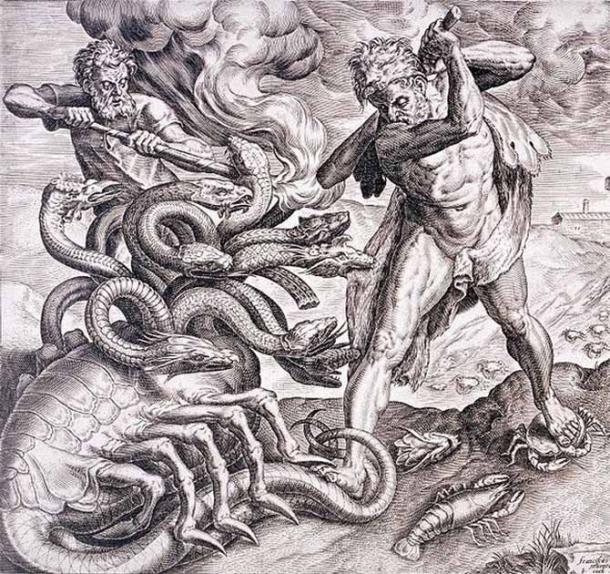
Engraving of the second labor of Hercules: slaying the Lernaean Hydra, child of Typhon and Echidna (Alagos / Public Domain)
Later authors kept adding to this strange little menagerie. In the 6th century BC, the mythographer Acusilaus added the Caucasian Eagle to the brood. This was the eagle that ate the liver of Prometheus every day. Another mythographer called Pherecydes added Ladon, a dragon, and the poet Lasus of Hermione added the famous riddling Sphinx.
Many later authors retained the above monsters, but would add other monsters to Typhon and Echidna’s festering nest of a family, such as the Gorgon (mother of snake-headed Medusa), the Colchian Dragon that guarded the Golden Fleece, and the harpies, along with others.
All in all, the offspring of Typhon and Echidna appear in a massive amount of Greek stories. The two are responsible for producing the majority of the monsters that Greek heroes like Hercules, Jason, and Odysseus had to fight.
Echidna in Mythology
For the most part, Echidna does not appear frequently in mythology. Her role is that of a background character. She is only really known as the lover of Typhon and the monster baby factory.
Hesiod described her as ageless and immortal. Most ancient Greek writers tied her demise to that of Typhon. When Typhon was finally defeated, he and his lover were either banished to Tartarus or buried under one of the great mountains.
Apollodorus, however, had a different fate in mind for Echidna. In his version of events, after Typhon was defeated, Echidna remained alive, living in a cave and preying on passing travelers. Hera recognized the threat that Echidna posed and hatched a plan. She sent her loyal servant, the giant Argus Panoptes, to kill Echidna. Argus snuck into Echidna’s cave and killed her while she was sleeping.
Some later stories mention heroes interacting with an echidna. Echidna seems to have become a catch-all term for several different snake-woman hybrids. In these myths, it is never clear if the writer is referring to the original Echidna or a copycat.
Typhon and Zeus
Unlike Echidna, Typhon played a major role in Greek mythology, namely at the end of the succession story, the Titanomachy. The Titanomachy is basically the origin story of the Olympian gods, such as Zeus and Hera.
It’s a long and winding story, but simply put, it revolved around the battle between Zeus and the earlier gods, the Titans. Zeus defeated his father, the Titan Cronus, freed his siblings, and became king of the gods.
Typhon came as the final threat Zeus had to face to consolidate his power. As mentioned earlier, Typhon’s parentage is up for debate, but he was usually depicted as being born with the sole purpose of defeating Zeus.
Typhon was first mentioned in Homer’s Iliad, which referenced Zeus striking the ground after defeating Typhon. It was Hesiod who gave the first detailed account of Zeus and Typhon’s meeting and battle. In this version of the story, when Zeus and Typhon fought, the entire earth and sky shook.
However, in Hesiod’s version, the battle was quite brief, and Zeus had little trouble taking Typhon down. Zeus simply attacked Typhon at range, hurling thunderbolt after thunderbolt at the monster. According to Hesiod, eventually, Typhon succumbed to Zeus’ bolts and was burnt to a crisp. Zeus then threw Typhon into Tartarus.
Epimenides (7th-6th century BC) had a different take. According to him, Typhon took a sneakier approach. Rather than risk an all-out fight with the mighty Zeus, Typhon chose to creep into Zeus’ palace and attack while he slept. Unfortunately for him, Zeus awoke just in time and killed Typhon with a thunderbolt.
Other versions of the tale upped the threat that Typhon posed to the gods. Nicander and Pindar claimed that Typhon presented such a threat that all the Olympians except Zeus and Athena fled from Typhon by transforming into animals. These versions sought to prove the superiority of Zeus. While the other gods fled, Zeus always managed to kill Typhon with a bolt.
Later versions turned the battle into a more dramatic affair. Rather than Zeus simply smiting Typhon with a thunderbolt from afar, these versions turned the battle into a multi-stage affair. In most of these versions, Zeus had the upper hand and repeatedly gave Typhon a thrashing. Each time Typhon was defeated, he ran away and hid. The battle acted as a sightseeing tour of ancient Greece and its neighbors.
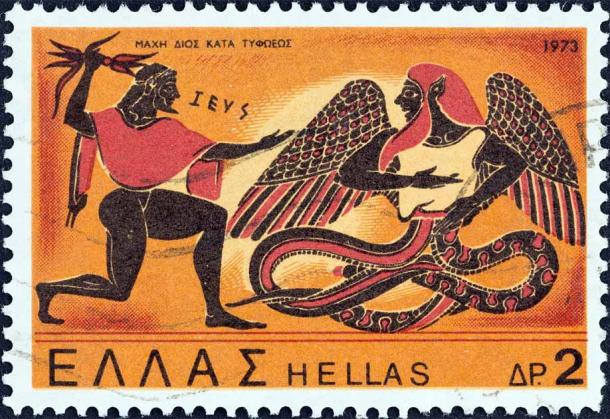
Zeus in combat with Typhon, partner of Echidna. Stamp created from image on 6th century BC pottery (Lefteris Papaulakis / Adobe Stock)
Nonnus and Apollodorus gave the most in-depth narrations of the battle. They still disagreed on quite a few details, but the broad strokes were the same. In their versions, Typhon was much more of a match for Zeus. Both versions of the tale handed Zeus an early victory by pelting Typhon with thunderbolts. However, in these versions, when Zeus closed in for the kill, he was outsmarted by Typhon. In both, Typhon managed to sever the sinews in Zeus’s arms and legs, leaving him unable to defend himself. Zeus was then left in a cave by Typhon. Although the details varied between versions, in both other Olympians then used trickery to come to Zeus’s aid, tricking Typhon into handing over Zeus’s sinews. Fully restored, Zeus then defeated Typhon in one last mighty clash.
What happened to Typhon after his defeat at the hands of Zeus largely depended on who was telling the story. Earlier versions had the simplest ending. According to them, Typhon was thrown into Tartarus along with Echidna, and there they were left for eternity.
Others had Zeus burying Typhon under various mountains, most commonly Etna. In these versions, Typhon repeatedly rallied against his imprisonment by sending fireballs into the sky and shaking the earth under the mountains. Typhon was used to explain the local volcanic activity. Eruption or earthquake? That’s Typhon showing his displeasure.
Conclusion
Typhon and Echidna are two of the more interesting minor characters from Greek mythology. Typhon acted as one last trial for Zeus before he could truly be declared king of the gods. One of the things which makes Greek gods interesting is their humanity, and their sheer fallibility. Later versions of the Typhon myth show this. Zeus only survived by the skin of his teeth and with the help of his family.
Echidna, on the other hand, is a more minor character. However, her impact on modern pop culture is hard to dispute. Anyone who has watched a fantasy film, read a fantasy book, or played video games has probably encountered one of Echidna’s brood.
One of the most impressive things about Greek mythology is that nothing stands on its own. Everything is interconnected; every character and monster has an origin story. This could not be truer than in the case of Echidna and Typhon; without them, most of the Greek heroes would have had nothing to fight.
Top Image: Typhon and Echidna were parents to a pantheon of Greek monsters. Statue of Echidna in Parco dei Mostri, Bomarzo, Italy Source: Public Domain
By Robbie Mitchell
References
Atsma, A. 2017. Typhoeus. The Theoi Project. Available at: https://www.theoi.com/Gigante/Typhoeus.html
Atsma, A. 2017. Echidna. The Theoi Project. Available at: https://www.theoi.com/Ther/DrakainaEkhidna1.html
Chavers, P. 2022. A Mythological Family of Monsters. History Daily. Available at: https://historydaily.org/a-mythological-family-of-monsters/5
Smith, W. 1873. Dictionary of Greek and Roman Mythology. London.















